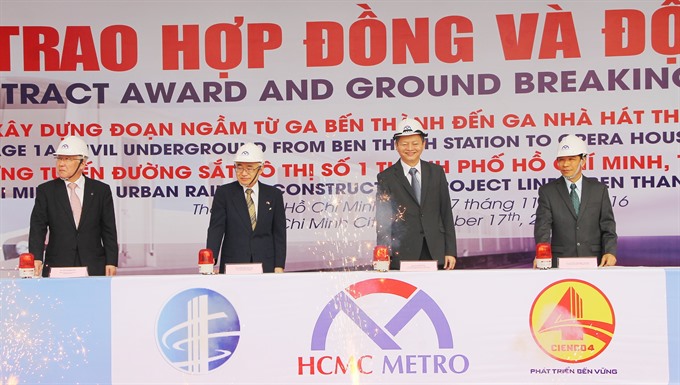 Society
Society

Construction of the Bến Thành central station and an underground section from there to the Opera House under a contract package for HCM City’s first metro line has begun, according to the city authority.
 |
| Ground was broken yesterday for package 1a of HCM City’s first metro route between Bến Thành Market in District 1 and Suối Tiên Amusement Park in District 9. VNS Photo Xuân Tình |
HCM CITY — Construction of the Bến Thành central station and an underground section from there to the Opera House under a contract package for HCM City’s first metro line has begun, according to the city authority.
It is the last of four packages for the first line linking Bến Thành market in District 1 to Suối Tiên Amusement Park in District 9.
The HCM City Management Authority for Urban Railways (MAUR) on Thursday held a ground-breaking ceremony for Package 1A and another to award the contract to the Sumitomo Mitsui – CIENCO 4 consortium.
The consortium bid VNĐ4.85 trillion (US$217.38 million) for it, according to MAUR.
Nguyễn Minh Quang, head of MAUR, said in addition to the central metro station, a 515-metre under Lê Lợi Street would also be built.
The station will have four basements, with B1 being 11,260 square metres and the others 6,785sq.m each, he added.
The other related works include three cooling towers and six entrances to the station.
Lê Văn Khoa, vice chairman of the city People’s Committee, said the other three packages are on schedule. The work began in August 2012.
The route is nearly 20 kilometres long, of which 2.6km is underground. It will have three underground and 11 elevated stations.
The test runs will begin in 2019 and the service a year later, two years behind schedule.
It would take passengers half an hour to commute between downtown HCM City and Suối Tiên Park. Trains will run at maximum speeds of 80km underground and 110km on the elevated stretch.
It is funded by the Japan International Cooperation Agency and reciprocal capital from the city.
The initial projected cost was $1.09 billion, but it has now soared to $2.49 billion.
Metro line No 5
In an effort to develop the metro system, the HCM City Management Authority of Urban Railways (MAUR) has urged the municipal authority to submit an investment proposal for the first phase of the metro line No 5 project to the Government and National Assembly for approval.
The metro line No 5 connects the Bảy Hiền intersection in Tân Bình District and Sài Gòn Bridge in Bình Thạnh District.
Investors have committed to fund the project at a cost of VNĐ41.607 trillion (US$1.85 billion).
The Spanish Government is investing $328 million, the Asian Development Bank (ADB) $567 million, the European Investment Bank (EIB) $179 million and the German Development Bank (KfW) $239 million. The remainder will come from the Vietnamese government.
The first phase of metro line No 5, with nine stations, will have a total length of 8.9 km, including 7.46 km underground and 1.43 km above ground.
In the first phase, the line will connect with metro line No 1 at the Sài Gòn Bridge and metro line No 2 at the Bảy Hiền intersection.
The next phase will connect with metro line No 3b at the Hàng Xanh intersection and metro line No 4 at the Phú Nhuận intersection.
Metro line No 5 will transport passengers from outlying areas to the city centre, which is expected to contribute to socio-economic development.
The line, expected to be put into operation by 2025, will be driverless, with automated ticketing systems and smart cards.
In a document sent to the city, MAUR said that amendments in the Law on Public Investment had delayed the approval process and the project.
Investors have expressed concern about the project’s approval process and capital disbursement.
MAUR has asked the city’s People’s Committee to consider submitting an investment proposal for metro line No 5 to the Prime Minister. If approved, it would then be sent to the National Assembly for ratification. — VNS




